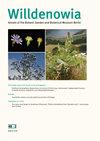Identity of the Calcarata species complex in Viola sect. Melanium (Violaceae)
IF 1.4
3区 生物学
Q2 PLANT SCIENCES
引用次数: 4
Abstract
The Calcarata species complex in Viola sect. Melanium (Violaceae) is a group of species from Italy and neighbouring islands. The complex is of considerable evolutionary interest because several hypotheses about hybrid speciation within the group have been previously proposed. Because the Calcarata complex is not well characterized morphologically, we used 142 samples representing 92 (of c. 120) species of V. sect. Melanium plus three outgroup species. Nuclear ITS and ETS and plastid trnS–trnG intergenic spacer sequences were analysed to test the monophyly of the Calcarata complex and to infer relationships among the constituent species. Both nuclear and plastid sequences resulted in very limited phylogenetic resolution. Based on the nuclear dataset, most species of the Calcarata complex were recovered in four clades that also contained species not previously associated with the complex. Results from the plastid dataset recovered most species of the complex in a large polytomy. However, one larger clade containing only Calcarata complex species could be recovered, and species of all four nuclear clades were part of this larger plastid clade. The Calcarata complex clearly could not be resolved as monophyletic. We hypothesize that the lack of phylogenetic resolution may result mainly from frequent hybridization and hybrid speciation, processes that are well documented for Viola and V. sect. Melanium.堇菜科堇菜科菖蒲属植物复合体的鉴定
紫百合科中的Calcarata物种复合体。黑色素(紫堇科)是一组来自意大利和邻近岛屿的物种。该复合体具有相当大的进化兴趣,因为之前已经提出了关于该类群内杂交物种形成的几个假设。由于Calcarata复合体在形态学上没有很好的特征,我们使用了142个样本,代表了V.sect的92种(约120种)。黑色素加上三个外类群。分析了核ITS和ETS以及质体trnS–trnG基因间间隔区序列,以测试Calcarata复合体的单系性,并推断组成物种之间的关系。核序列和质体序列都导致非常有限的系统发育分辨率。根据核数据集,Calcarata复合体的大多数物种在四个分支中被发现,这些分支也包含以前与复合体没有关联的物种。质体数据集的结果在一个大型多面体中恢复了复合体的大多数物种。然而,一个更大的分支只包含Calcarata复杂物种,并且所有四个核分支的物种都是这个更大的质体分支的一部分。Calcarata复合体显然不能确定为单系。我们假设缺乏系统发育分辨率可能主要是由于频繁的杂交和杂交物种形成,这一过程在Viola和V.sect中得到了充分的证明。黑色素。
本文章由计算机程序翻译,如有差异,请以英文原文为准。
求助全文
约1分钟内获得全文
求助全文
来源期刊

Willdenowia
PLANT SCIENCES-
CiteScore
4.60
自引率
5.30%
发文量
17
审稿时长
>12 weeks
期刊介绍:
Willdenowia is an international peer-reviewed journal publishing original research articles in English from the entire fields of plant, algal and fungal systematics, covering the evolution, taxonomy and nomenclature of these organisms as well as related fields such as floristics and plant geography. Articles on phylogeny and molecular systematics are especially welcome, as are review articles. Descriptions of new taxa may be considered, but only if supported by robust evidence. Narrowly regional studies of widespread taxa, routine typifications, checklists and new floristic records are generally not considered (excluding contributions to the Euro+Med-Checklist Notulae). Authors are encouraged to deposit duplicates of their material, especially nomenclatural types, in the Berlin herbarium (B).
 求助内容:
求助内容: 应助结果提醒方式:
应助结果提醒方式:


